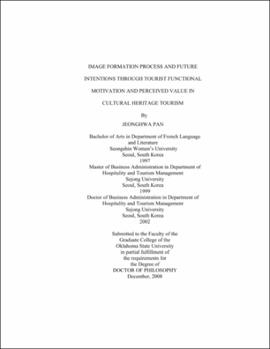| dc.contributor.advisor | Qu, Hailin | |
| dc.contributor.author | Pan, Jeonghwa | |
| dc.date.accessioned | 2013-11-26T08:33:26Z | |
| dc.date.available | 2013-11-26T08:33:26Z | |
| dc.date.issued | 2008-12 | |
| dc.identifier.uri | https://hdl.handle.net/11244/7266 | |
| dc.description.abstract | Scope and Method of Study: The purpose of this study was to 1) develop a theoretical structural model of cultural heritage tourism, destination image formation, and future intentions by investigating functional motivation, perceived value, and motivational conflicts in cultural heritage tourism and to 2) test empirically the conceptual model of relationships among the constructs at Gyeongju City in South Korea as a cultural heritage tourism destination. Data were collected from tourists visiting the city of Gyeongju in South Korea. Participants were able to choose from four different versions of the survey: English, Korean, Japanese, and Chinese. To identify the structural relationships among the constructs, the LISREL procedures were adopted in Phase 1. In addition, the difference of gender and the moderating effect of cultural distance were examined in Phase 2, by applying t-test, one-way ANOVA, and multiple regression. | |
| dc.description.abstract | Findings and Conclusions: By applying the tourist functional motivation, the study found six functional motivations in the cultural heritage tourism area: learning, novelty-seeking, pleasure, escape, socialization, and value-expressive. The five perceived values examined were functional value, social value, emotional value, epistemic value, and conditional value. The results of this study documented that high-knowledge motivation cultural tourists were significantly more satisfied with their experience than were low-motivation cultural tourists. Those who have high knowledge motivation tend to have high emotional value, in turn; the emotional value may cause high epistemic and functional value, which finally forms their total experience. The study also found that females are more interested in cultural heritage tourism than males, and western tourists differed from eastern tourists in terms of their travel behavior and motivation. Also, there were significant differences between domestic and international tourists in terms of their cultural heritage tourism behavior. | |
| dc.format | application/pdf | |
| dc.language | en_US | |
| dc.rights | Copyright is held by the author who has granted the Oklahoma State University Library the non-exclusive right to share this material in its institutional repository. Contact Digital Library Services at lib-dls@okstate.edu or 405-744-9161 for the permission policy on the use, reproduction or distribution of this material. | |
| dc.title | Image formation process and future intentions through tourist functional motivation and perceived value in cultural heritage tourism | |
| dc.contributor.committeeMember | Leong, Jerrold K. | |
| dc.contributor.committeeMember | Njite, David | |
| dc.contributor.committeeMember | Brown, Tom J. | |
| osu.filename | Pan_okstate_0664D_10097.pdf | |
| osu.accesstype | Open Access | |
| dc.type.genre | Dissertation | |
| dc.type.material | Text | |
| thesis.degree.discipline | Hospitality and Tourism Management | |
| thesis.degree.grantor | Oklahoma State University | |
